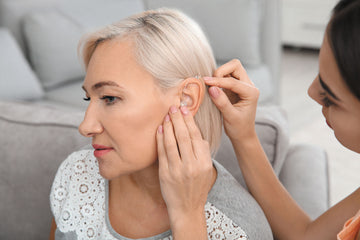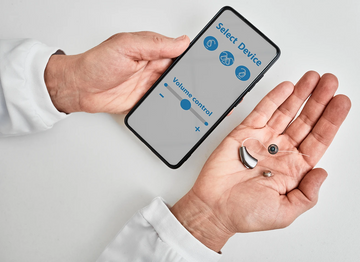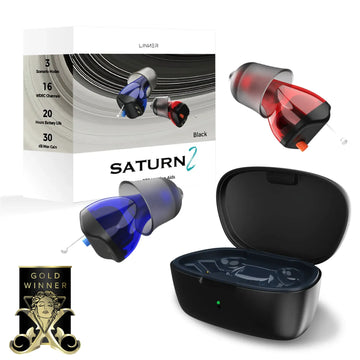Hearing aids are essential devices for many individuals, helping them navigate daily life by improving their hearing capabilities. However, one of the most common frustrations users experience is the rapid depletion of hearing aid batteries. You might find yourself changing or charging batteries far too frequently, which can be time-consuming and costly. Understanding why this happens and learning how to manage your hearing aid's battery life more effectively can help extend its lifespan and save you money.
What Is the Most Suitable Battey Life for a Hearing Aids
Hearing aid users typically need to wear our devices continuously throughout the day, making battery life a crucial factor. Generally, a hearing aid should provide at least 15 hours of battery life on a single charge to meet daily usage demands. This ensures that users can rely on their devices from morning to evening without frequent recharging or battery replacements. Longer battery life also enhances convenience, especially for individuals with active lifestyles or limited access to charging options.
Different Types of Batteries in Hearing Aids
Understanding the type of battery your hearing aid uses is crucial in addressing the issue of rapid battery depletion. There are two primary types of batteries found in hearing aids: disposable zinc-air batteries and rechargeable lithium-ion batteries. Both have their pros and cons.
1. Zinc-Air Batteries (Zinc-Air Battery)
Zinc-air batteries are the most commonly used batteries in hearing aids. These batteries are small, affordable, and easily available. However, one of their main drawbacks is that they need to be replaced frequently. Zinc-air batteries are activated when exposed to air, so when you remove the tab from the battery, it begins to deplete, regardless of whether the hearing aid is in use.

Pros of Zinc-Air Batteries:
- Widely available and inexpensive.
- Lightweight and small, ideal for hearing aids.
Cons of Zinc-Air Batteries:
- Shorter lifespan compared to rechargeable batteries.
- Requires frequent replacement, which can add up in cost over time.
- Not eco-friendly, the used battery is difficult to handle
2. Lithium-Ion Batteries
Lithium-ion batteries are increasingly popular in modern hearing aids due to their rechargeable capability. Unlike zinc-air batteries, lithium-ion batteries are rechargeable, meaning you don't have to replace them frequently. Instead, you can simply charge them daily or as needed, making them a more eco-friendly and cost-effective option in the long run. However, while you won't need to replace the battery itself, the capacity of the battery may degrade over time, which could lead to shorter battery life.
Pros of Lithium-Ion Batteries:
- Rechargeable, reducing the need for constant replacement.
- Longer-lasting battery life per charge compared to zinc-air batteries.
- Eco-friendly and cost-effective over time.
Cons of Lithium-Ion Batteries:
- May lose capacity with extended use, reducing the number of hours of use per charge.
- The initial cost of hearing aids with lithium-ion batteries may be higher.

Factors That Matter: The Battery Life
Several factors affect the longevity of your hearing aid battery, regardless of whether you use zinc-air or lithium-ion batteries. Below are the key factors that can significantly influence how long your hearing aid batteries last.
1. Volume
The volume setting on your hearing aid has a direct impact on battery life. The higher the volume, the more power your hearing aid consumes. If you find that your hearing aid’s battery is dying quickly, consider reducing the volume when possible. Some models offer features that allow you to adjust the amplification based on your environment, which can help conserve battery life.
2. Environmental Sound Level
The level of ambient noise in your environment also plays a role in battery consumption. If you are in a noisy environment, such as a crowded restaurant or a busy street, your hearing aid will work harder to filter and amplify sounds. This increased effort results in faster battery consumption. On the other hand, if you're in a quiet environment, your hearing aid doesn't have to work as hard, and the battery will last longer.
3. Bluetooth Usage
Many modern hearing aids come with Bluetooth connectivity, allowing you to stream audio directly from your phone or other devices. While this feature is incredibly convenient, it can also drain the battery faster. Bluetooth technology requires additional power to maintain the connection and stream audio. If you use Bluetooth frequently with your hearing aids, expect the battery to deplete more quickly.
How to Extend the Life of Zinc-Air Hearing Aid Batteries
To get the most out of your hearing aid batteries, you can implement a few simple practices that will help extend their lifespan.
1. Turn Off Your Hearing Aids When Not in Use
When you're not using your hearing aids, make sure to turn them off. This will prevent unnecessary battery drain. If your hearing aids do not have an on/off switch, open the battery compartment to turn them off.
2. Store Batteries Properly
Zinc-air batteries should be stored in a cool, dry place and away from direct sunlight. Avoid keeping batteries in the hearing aid when not in use for extended periods, as this can cause them to deplete faster.
3. Adjust the Volume
As mentioned, lower the volume on your hearing aids when possible. This reduces the energy needed to amplify sound, thus conserving battery life.
4. Use a Dehumidifier
Moisture can damage hearing aid batteries and affect their performance. Using a dehumidifier or a drying box at night can help extend the life of both your batteries and the hearing aid itself.
5. Replace Batteries Regularly
Even if you are using rechargeable batteries, be sure to replace them when they no longer hold a charge for a sufficient amount of time. For zinc-air batteries, make sure to replace them before they are completely drained.

How to Extend the Life of Lithium-Ion Hearing Aid Batteries
To get the most out of your lithium-ion hearing aid batteries and maximize their performance, there are some simple and effective practices you can implement to extend their lifespan.
1.Correct Charging
Avoid overcharging, unplug the charger in time after the battery is fully charged; avoid over-discharging, charge when the battery is about 20%-30% left; use the original charger to ensure that it matches the battery.
2.Reasonable Use
Turn off the hearing aid when not in use and control the usage time; avoid using it in high and low temperature environments, such as direct sunlight, hot car or cold outdoors; prevent moisture, keep the hearing aid and battery dry, and wipe off the water that may be stained after use.
3.Correct Storage
If not used for a short period of time, put the battery in the closed hearing aid after fully charging, and store it in a dry and cool place; if not used for a long time, remove the battery after charging to 50%-60%, store it separately in a dry, cool and ventilated place, avoid contact with metal, and charge it to 50%-60% every other month before storing it.
4.Regular Cleaning
Clean the dirt and earwax on the earplugs, ear molds and other parts regularly to prevent debris from entering and affecting the performance and causing abnormal battery consumption.
5.Regular Inspections
Go to a professional institution regularly to conduct a comprehensive inspection and maintenance of your hearing aids, test the battery performance, and replace the batteries in a timely manner if you find problems such as bulging, leakage, abnormal charging, etc.
Recommended Hearing Aids with Ultra-Long Battery Life
If you’re tired of constantly replacing hearing aid batteries, consider investing in models designed for ultra-long battery life. Some hearing aids are equipped with advanced power-saving technology, allowing them to last for longer periods between charges. Rechargeable hearing aids, in particular, can be more convenient, as they eliminate the need for frequent battery changes. Here are some hearing aids known for ultra-long battery life
1. Linner Saturn 2 OTC Hearing Aids
Battery Life: 10 hrs to 20 hrs
Color: matte black, beige gold
2. Linner Mercury OTC Hearing Aids
Battery Life: up to 20 hrs Color: beige gold
Frequently Ask Questions
How Much Does It Cost to Replace Hearing Aid Batteries?
The cost of replacing hearing aid batteries depends on the type of battery your device uses. Zinc-air batteries typically cost between $1 and $2 per battery, and each battery lasts about 5–7 days. In comparison, rechargeable lithium-ion batteries are more expensive upfront, but they can last for several years without needing replacement.
How Do I Know If My Hearing Aid Magnet Needs to Be Replaced?
A hearing aid magnet helps retain the ear mold in place, and if it becomes weak or damaged, it may not hold the mold properly. Signs that the magnet may need replacement include discomfort or difficulty keeping the ear mold in place.
Do Hearing Aids Consume Power When Not in Use?
Yes, hearing aids can consume some power even when not in use, especially if they are not turned off or stored properly. For models with rechargeable batteries, they will continue to use a small amount of power even when placed in the charger. However, this consumption is usually minimal compared to when the hearing aid is in active use.







![Linner Mercury Clarity OTC Hearing Aids [FSA & HSA Eligible] Linner](http://www.linnerlife.com/cdn/shop/files/Linner-Mercury-Clarity-OTC-Hearing-Aids-_FSA-_-HSA-Eligible_-Linner-110038953.webp?v=1725853434&width=360)

![Linner Mars OTC Hearing Aids [FSA & HSA Eligible] Linner](http://www.linnerlife.com/cdn/shop/files/Linner-Mars-OTC-Hearing-Aids-_FSA-_-HSA-Eligible_-Linner-110039213.webp?v=1725865495&width=360)
